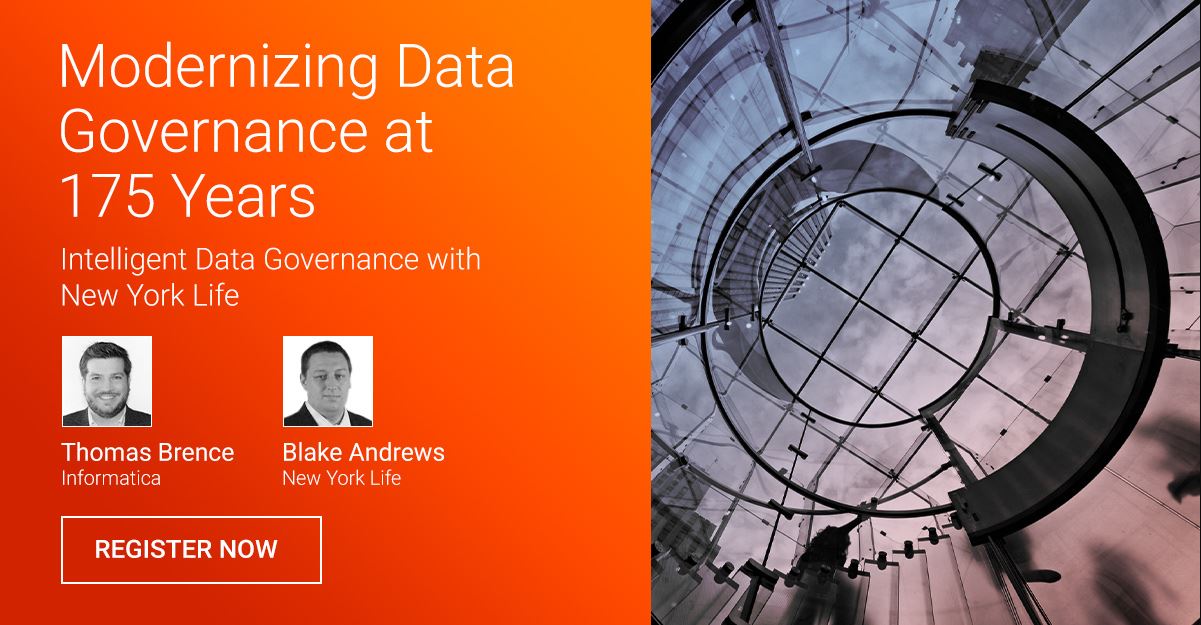Overcoming the Operationalization Challenge with Data Governance at New York Life
So, you’ve decided to start an enterprise data governance program (or been tasked with it)—now what do you do? What’s the best first step? Do you set up a steering committee? What should you choose as your first project? Will you be more successful if you establish a DACI working model? Should you scramble to comply with a new regulation? Or would it be more strategic if you prepare for one on the horizon?

Even after you’ve selected from an endless list of potential first steps, it doesn’t get any easier. In fact, the biggest challenge isn’t deciding on the first step: it’s actually deciding what your second step is going to be.
The reason that the second step is so crucial: gaining momentum with an enterprise data governance program isn’t easy. There is no cookie cutter approach, no single guide, no foolproof recipe to follow that can take you from step one to step two to step one hundred (and beyond). Every organization is different. Every organization has its own shorthand and culture, and each scenario will supply its own shade and nuances.
Fortunately, the one thing we can turn to is an ability to learn from those that have been there, who have embarked on a similar journey and led the way. If you’re researching how to operationalize a data governance program, there are few better examples than New York Life.
On March 25th, the third episode of our Data Empowerment Experts series features New York Life. If you’re headed into the unknown, wouldn’t it be great to take a fast-forward look at what your governance will look like, one year from now? That’s what we’ll explore together with New York Life.
As we have done with each of our Data Empowerment Experts, I sat down with Blake Andrews, the Corporate Vice President of Data Governance Capabilities and Delivery at New York Life, for a discussion of his views on data governance and how it can be leveraged to empower the rest of your organization to deliver business value. Here is our Q & A:
Question: How do you choose where to start?
Answer: My advice would be to start with a project that is aligned to your organization’s strategic objectives. This is going to give your program visibility and will show how you can contribute to the bottom line. The trick is that many of these large, strategic projects have lengthy timelines that are going to extend your time to value. To combat this, you have to find a way to accelerate your delivery, typically by narrowing your focus to a single data domain or subject.
Our first project is a prime example of this, and it involved a major strategic initiative to define an enterprise-wide logical data model that was then converted into a physical data model to serve as the basis for our enterprise reporting and analytics. Obviously, this represented a very large, multi-year effort, and our team wanted to seize the momentum and show results within the first 120 days. We narrowed our focus to the most critical data elements for a single domain and leveraged all three tools—Axon Data Governance, Enterprise Data Catalog, and Informatica Data Quality—to create a really robust and rich experience around that data. This included glossary terms mapped to physical stores, business and technical lineage, and data quality metrics. This “rich experience,” as we termed it, really brought the capabilities offered by these three tools to life and made the results tangible.
Question: How do you maintain momentum?
Answer: In our experience, the “build it and they will come” approach only works for a cornfield in Iowa. We have focused a lot of energy on adoption and building a pipeline of opportunities, and this really starts with the visibility that our strategy of aligning to the company’s strategic initiatives. That rich experience that I discussed previously becomes the basis of a demo that we will deliver to every data practitioner we can find. We leverage our network of data stewards across the company to work with their stakeholders to identify the problems that their data teams are facing and look for opportunities to provide solutions. It’s almost a sales mentality where you are sourcing prospects, nurturing relationships, and presenting a collection of tools to meet their needs. Once you’ve got that initial buy-in and start the project, the focus of our data governance office and our data stewards then shifts to execution and ensuring that we deliver a high-quality product that we can showcase to lead to our next opportunity.
Question: How do you address scale?
Answer: This is something that I will discuss in the webinar, but we leverage the evolving capabilities of the tools to help us scale our capacity, both in data stewardship and user engagement. The AI capabilities of the CLAIRE engine in EDC is a tremendous benefit when dealing with data at scale. This includes activities such as auto-tagging data assets with glossary terms and using data domains to find the sensitive data types—such as PII, PHI, and PCI—that our compliance teams are most concerned with. From a user engagement standpoint, Axon is really the cornerstone of enhancing data literacy and democratizing data. We look at Axon as a data governance portal that will be the sole engagement point for approximately 80% of our data practitioners. It’s vital that the information in Axon Data Governance is presented in a way that marries the business and technical contexts of the data.
Question: How do you measure success?
Answer: It’s a combination of both quantitative measures and qualitative observations. Obviously, there are the data quality metrics that our stewards define, but we also have KPIs and metrics to measure the volume, maturity, completeness, and quality of content, as well as the adoption and impact of our solutions. The metrics typically should start on the content side because you must have a product before you can get adoption. Once you’ve achieved that minimum viable product and have started rolling it out to users, that’s when you can start looking at adoption and impact.
On the qualitative side, one of the indicators of success we look for is completing the cycle, or “feeding the beast” as we call it. It’s the point where someone who was consuming information from these tools begins to publish information in the tools. It could be the definitions for a new report that they developed or the lineage of data that is being sourced for a new solution. When you see consumers becoming publishers, this is an indicator of success.
Question: How has data privacy been a factor?
Answer: We’ve crossed the threshold in society where data privacy is always going to be a factor. Even though our data governance organization is primarily focused on driving business value through better data, our second or third use case for Axon was to build an inventory of the data that was in scope for the California Consumer Privacy Act (CCPA). These efforts are great when you know the data and where to find it, but as with so many organizations, it’s the data that you don’t know you have that often poses the most significant risk. We’ve also employed EDC to help us identify sensitive data so that we can take steps to protect it through encryption and tokenization.
Question: How do you empower the business to drive value?
Answer: The mission of our data governance team is to drive better business outcomes through better data, and that ties back to all of these things I’ve mentioned previously. We drive democratization and self-service through Axon, which has become a one-stop-shop for users to find data as well as understand its meaning and its quality. EDC and IDQ are complimentary tools that serve as the backbone to the information that the data stewards publish in Axon. This is all designed to create better outcomes and drive efficiency. One of the most rewarding comments our team has received was when a business analyst told us a few months ago that they were able to complete the analysis on a system in a matter of days that would have otherwise taken between 4 and 6 weeks. Hearing those anecdotes are ultimately the success that you’re looking for because they tie back to efficiency and effectiveness.
To learn even more about Blake and New York Life’s journey, check out the webinar on March 25th.
Learn more—about this or any other webinar in our Data Empowerment Experts series—at www.informatica.com/dataexperts.









